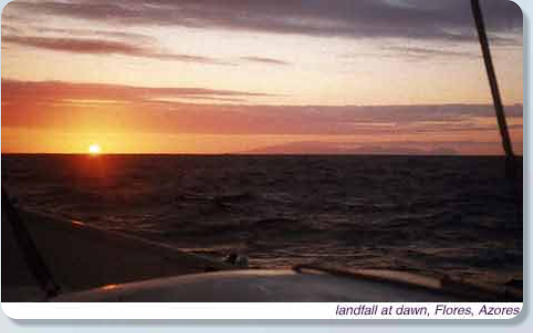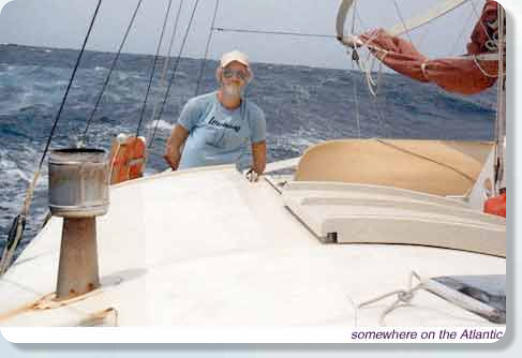Chapter 6 — Toward the Rising Sun
The forecast for July fourteenth 1988 was clear with light winds so we spent the thirteenth rushing around Bridgewater doing last minute shopping. Next day the sun rose into a clear blue sky over a flat calm. We motored two miles to the Mosher Island lighthouse where we were to take on fresh unrefrigerated eggs and vegetables. While we were having an early cup of coffee there with Tom and Anne we heard the automatic fog horn start up. Outside the visibility had dropped to less than a quarter mile. I did not fancy drifting around off that rocky shore in fog with no wind so we delayed our departure and spent the day doing farm chores—getting our hands dirty! That evening we returned to Oborea laden with fresh vegetables that would last most of the voyage. July fifteenth brought south west winds and only a little fog so we got under way. Our route across the Atlantic was to be a compromise; north of forty degrees a series of lows head east north-east, pulling strong west winds along south of them. South of forty degrees is an area of lighter variable winds dominated by the Azores High. Somewhere in between the winds should be just right. Our plan was to sail south east until we reached forty degrees, then follow this parallel until the great circle route branched south to the island of Faial in the Azores. Day one. The fog cleared a bit in the afternoon and we saw a few fishing boats. After nightfall the fog came back, but the wind continued on the beam at about force two. Day two. The fog cleared in the morning and this was to be the last of it. The wind continued light on the beam and our noon to noon run was one hundred and eight miles. We were passing over the edge of the continental shelf and the profusion of wildlife was quite incredible. We saw whales and dolphins, great flocks of shearwaters, gannets, gulls terns and petrels. Day three. The wind continued from the south west and our run was one hundred and twenty eight miles. Daytime temperatures were about twenty four degrees but we had left most of the wildlife behind although we still saw the occasional dolphins, shearwaters and petrels. Day four. Winds from the south west at force four to five and we were travelling fast. The seas got a bit lumpy though, and we reduced sail to slow down; our day's run was one hundred and seventy eight miles. We saw our first cargo ship, a westbound bulk carrier about six miles off. We also saw our first flying fish of the trip and a beach ball heading for Iceland. Day five. We reached the forty degree parallel and hurried east. Winds were a steady force five with steep following seas and we were down to double reefed mainsail and jib. Our day's run was one hundred and ninety two miles, a new record for Oborea. At dusk we dropped the main and went to twin goose- winged headsails for a slower but more comfortable night. Day six. The steep following seas continued and our run was one hundred and thirty six miles. By afternoon things eased up a bit and we rehoisted the main with a single reef. Saw dolphins playing in the surf and lots of Portuguese men of war drifting east. Day seven. At two in the morning we passed the halfway point of the voyage, but the second half was likely to be slower than the first. We celebrated by baking a batch of chocolate cookies. Saw two ships, but none closer than about three miles. Our run, in smoother seas, was one hundred and sixty six miles. Day eight. A frustrating day; after a good start the wind headed us in the afternoon and we ran to the south east close hauled. By midnight the wind died completely and we were becalmed. One hundred and ten miles today. Day nine. Sunny and hot (twenty nine degrees). Light north west winds wafted us along at two or three knots. A good day for sunbathing, but our run since noon yesterday was only twenty miles. Day ten. Wind continued from the north-west a little stronger than yesterday and we covered one hundred and forty two miles. A school of about forty spotted dolphins played around the boat for a while, making spectacular leaps into the air. Day eleven. Hot with rain showers. The wind gave out in the morning and we spent the rest of the day becalmed. Our run was ninety nine miles, only four hundred and fifty miles to Horta; all we needed was a little wind. Day twelve. Still hot and humid. At five in the morning a light north west wind sprang up and continued all day, but our run to noon was only forty five miles. Day thirteen. A beautiful full moon night. Good sunbathing weather during the day. We made slow but steady progress in the right direction under force three winds from the west north-west. Covered one hundred and ten miles. Day fourteen. Heavy rain showers all night and each brought a change in wind. We were kept pretty busy sail handling. By noon the wind had settled dead ahead and we were bounding north east on the starboard tack. Our original course would have taken us about sixty miles south of the island of Flores, but this new tack would take us close so we may just shelter there until the winds shift. By midnight we were down to double reefed main and jib and pounding into short steep seas. Day's run: one hundred and four miles. Day fifteen. As day broke the islands of Flores and Corvo were clearly visible ahead although still thirty five miles away. All morning we got nearer, still close hauled. These volcanic islands seemed incredibly high and precipitous with great cliffs rising straight from the sea. Above the cliffs the startlingly green land rose steeply to the centre of the island. All was divided into fields, and as we got closer we could see cows in the fields and white stucco farm houses with red tiled roofs. There are no proper harbours on Flores (indeed there are only two or three in all nine islands of the Azores) one just anchors in a sheltered cove, prepared to move if the wind shifts. Santa Cruz, the principal town of Flores is on the east side, the windward side when we got there, not a good place to stop, so we finally dropped anchor in a little cove, un-named on my chart, under towering hundred foot cliffs. We had covered 1,607 miles from Nova Scotia in fourteen days and nine hours. After two weeks at sea my crew Daniel was anxious to get ashore and stretch his legs. We could see steps cut down the cliff at one point and assumed there must be some kind of landing so I rowed him ashore. In fact we found no landing and he had to scramble ashore as best he could as I backed the stern of the dinghy close to the rocks in the three foot swells. He made it with only one wet leg, and in two hours he was back with a bottle of wine and a bag of shrimps. He had met a couple of locals who had taken him to their little village where they had wined and dined him before sending him back with the gifts for me. They would accept no payment he told me; This was our welcome to the Azores.
